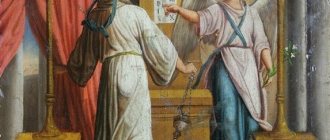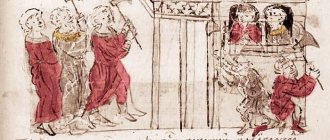In memory of the Holy Virgin Juliana of Olshanskaya
A heartfelt song from Tatiana Lazarenko’s author’s album “Shrines of the Eternal City” is dedicated to the holy virgin Juliana of Olshansk, whose relics rest in the Near Caves of the Kiev Pechersk Lavra (July 19 and October 11).
I look into your face with reverence, Holy Virgin, pure color. The Lord called His beloved creation in the prime of life. She left without tears, impertinent reproaches, mourned by the groom, under the canopy of the Pechersk monastery, under the Intercession of the Mother of God. She rested as flesh in the Lavra's bosom. She is beautiful and bright in soul and has risen on the spiritual horizon as a morning star. Vine from the family tree, the Lord has called you to Himself. The holy destiny of the Most Pure Virgin has become your destiny forever. I will come to your incorruptible relics, I will cry, I will quietly pray, I will look into your image, meek and humble, through the dust of gray centuries. I pray, Juliana is a virgin, save the soul of a sinner. To the sounds of the Lavra chant, lift up your prayer to Heaven. Poems by Tatiana Lazarenko Music and vocals by Elena Zalevskaya
Video by Oksana Belyaeva
History of the discovery of the relics
At the beginning of the 17th century, under Archimandrite Elisha Pletenetsky (1599-1624), the holy relics of righteous Juliana were found incorrupt. When digging a grave near the Assumption Church, near the chapel in the name of the holy Apostle and Evangelist John the Theologian, they discovered a tomb on which was nailed a tablet with the coat of arms of the Olshansky princes and the inscription: “Iuliania, Princess Olshansky, daughter of Prince George of Olshansky, who died as a virgin in the sixteenth year of birth." When they opened the coffin, they saw Saint Juliana as if sleeping; she was dressed in silk clothes embroidered with gold, her neck and hands were decorated with jewelry, and her head was crowned with a gold crown with pearls. But as soon as they touched her clothes, they crumbled into dust. All that remained was her incorruptible body, which death seemed not to dare to touch, and also precious jewelry on her hands. The holy maiden was dressed in new clothes and laid in the southwestern corner of the Great Assumption Church, but without the honor due to saints. In 1617, an Arian heretic named Vasily came to the Assumption Church and asked Ecclesiarch Liverius to open to him the tomb of the righteous Juliana. Venerating the holy relics, he stole a precious ring from the saint’s hand. But when the blasphemer left the temple with the kidnapped man, he fell at the church doors and died. When examining the body of the deceased, they found the ring of the holy virgin and understood the reason for his sudden death. A little time passed, and Saint Juliana appeared in a miraculous vision to Archimandrite Peter Mogila (later Metropolitan of Kiev), denouncing him for his neglect of her holy relics and for his lack of faith in them. Then that zealous shepherd immediately commanded the skilled and pious virgins of the monastic order to prepare worthy attire and splendid utensils for the holy relics. At his command, a new shrine was also made, into which the holy relics were honorably placed. Having put on the holy clothes himself and convened the entire consecrated cathedral, Peter Mogila performed their solemn transfer to another place and celebratory prayer and singing, with thanksgiving to God and the Mother of God and the reverend Fathers of Pechersk and for the appearance of the honest relics of the holy virgin. From then on, it was customary to commemorate the holy righteous Juliana on the day of the discovery of her venerable relics, July 6/19, for many who came to her with faith received healing. Righteous Juliana also appeared among many holy virgins to the abbot of the Golden-Domed Kyiv Monastery, Theodosius. At the same time, she said to the abbot: “The Lord showed you this vision for this reason, so that you would know that I, too, was numbered by the Lord among the holy virgins who pleased Him.” During the fire of the Assumption Church in 1718, the holy relics of Righteous Juliana were burned. Their remains were transferred to the Near Caves of the Kiev Pechersk Lavra. In 1889, at the request of Archbishop Modest of Volyn, part of the holy relics was transferred to the Cathedral of Zhitomir.
Author:
Tatiana
We publish in the telegram earlier than on the website. Subscribe to the Pravlife Channel
Righteous Juliana of Olshanskaya, Pecherskaya, princess, maiden
After Kyiv annexed Lithuania, the city was ruled by the Olshansky family of princes. In the middle of the 16th century, one of them, Prince Yuri Dubrovitsky-Olshansky, lost his daughter Juliania. She died a virgin at the age of 16. Her father was a benefactor of the Kiev Pechersk Lavra, and therefore the princess’s body was buried near the Great Lavra Church.
At the beginning of the 17th century, under Pechersk Archimandrite Elisha Pletenetsky (1599–1624), while digging a grave, a coffin with the incorrupt body of a girl was found. On the silver plate of the coffin there was an inscription: “Iuliania, Princess Olshanskaya, who died in the 16th year.” The princess lay in the coffin as if alive, in a white dress trimmed with gold, with many precious jewelry. Her body was transferred to the Great Lavra Church.
In the 17th century, Saint Juliana appeared to the Kyiv Metropolitan Peter Mohyla and reproached him for his lack of faith and neglect of her relics. After this, the Metropolitan ordered that the saint’s relics be placed in a precious shrine with the inscription: “By the will of the Creator of Heaven and Earth, Juliana, the helper and great intercessor in Heaven, lives throughout the years. Here bones are a medicine against all suffering... You adorn the villages of paradise with yourself, Juliania, like a beautiful flower.” At the reliquary of the relics of Saint Juliana, many miracles and grace-filled healings were performed. There was a case when a thief who made his way into the church stole a precious ring from her relics, but as soon as he left the doors of the temple, he screamed in a terrible voice and fell dead.
One day, the holy virgin Juliana appeared to the abbot of the Kyiv St. Michael’s Monastery and told him: “I am Juliania, whose relics lie in the Pechersk Church. You consider my relics to be nothing. For this reason, the Lord is sending you a sign so that you understand that the Lord God has counted me among the holy virgins who pleased Him.” Since then, the veneration of Saint Juliana has increased even more.
In 1718, the relics of the saint burned in a fire in the church. Their remains were placed in a new shrine and placed in the Near Caves of the Kiev Pechersk Lavra. The holy righteous virgin Juliana became the second of the holy wives of Rus' who were honored to be buried in the Lavra caves. On the icons, Saint Juliana is depicted in the Cathedral of the Holy Fathers of the Kiev Pechersk Lavra.
Saint Juliana is the first helper to Russian women in healing diseases of the soul. She stands for them, together with other saints of the Russian land, before the Most Pure Mother of the Lord and, together with Her, before the Throne of the Holy Trinity. Let us pray to the holy righteous virgin Juliana, Princess Olshanskaya, for her earthly sisters - the women of Russia, so that she will help heal their souls, help them find spiritual joy and consolation.
Biography
Quite little is known about Saint Juliana; moreover, the figure of this woman is one of the most mysterious in Orthodoxy. It is known that she died at the age of 16, unmarried, but remaining pure. The cause of Juliania’s death remains unknown, as well as why the remains of the young princess, discovered in the early 17th century near the Kyiv Lavra, remained incorrupt. Why did God choose this modest, even inconspicuous virgin?
Holy Righteous Juliana of Olshanskaya
Origin and birth
Juliania came from the old family of the Olshanskys (Golshanskys). In those days, Kyiv was part of the Principality of Lithuania and was ruled by the Olshansky princes, among whom was Juliania’s father, Gregory. Little is known about him, for example, that he expressed his patronage of the Kiev Pechersk Lavra with great zeal and was a devout person.
It was in such an Orthodox family that a girl was born, who, according to tradition, was named Juliania. From early childhood, Juliana was surrounded by monks and priests, from whom she bit by bit absorbed the concept of Christian virtues and love for the Lord in general.
More about women glorified in Orthodoxy:
- Saint Valentine of Minsk
- Holy Martyr Lyudmila
- Saint Angelina of Serbia
However, despite her short but righteous life, according to some authors, Juliania was unable to avoid the so-called “curse of the Golshansky family,” due to the fact that by the end of the 16th century there was not a single descendant of this truly noble family.
Interesting! Many women of this kind, even if they died in old age, but, alas, remained childless during their lifetime. According to one assumption, the same fate befell Juliana.
In the 16th century, most girls got married quite early and at the age of 16 were already adult women with children. Historians of Orthodoxy have never solved the riddle - why did the young beautiful Princess Olshanskaya, having lived to the time when the girl was considered “marriageable”, remain undetected?
Juliania Olshanskaya died around the middle of the 16th century, but her body was discovered only at the beginning of the 17th century under Archimandrite Elisha Pletenetsky. Unfortunately, a fire that happened in one of the churches of the Kiev-Pechersk Lavra in 1718 destroyed the holy relics of the Virgin Juliana, and the ministers, placing the remains of them in a shrine, placed them in caves where hermit monks once lived.
After some time, Archimandrite Peter of Kiev began to often see the saint in a dream, who reproached him for the lack of proper attention to her coffin and therefore ordered a new shrine to be made for the relics, as it was decided to do.
Greek names compatible with the name Juliana
Kira, Inna, Praskovya, Ksenia, Kirilla, Evgenia, Elena, Efimia, Euphrosyne, Anfisa, Agap, Agathon, Adrian, Taras, Socrates, Alexey, Nikita, Nikon, Pamphilus, Polycarp.
Check also the compatibility of other names with the name Juliana.
Often people have a question about when to celebrate the day of the angel, that is, name day. In theory, this is the holiday of the saint in whose honor the person was named during baptism. But there can be many saints of God with the same name. How can you find out exactly who you are if you were baptized in childhood and no one remembers in whose honor? In such cases, they choose as their patron the saint whose memory in the church calendar is closest to the person’s birthday.
Below we present, accompanied by brief biographies, the main dates when the day of the angel Julia can be celebrated. But first it should be noted that this name does not exist in the Orthodox tradition. According to the church calendar, Angel Julia's Day will be celebrated in memory of Saint Juliana or Julia. It is these names that are the church equivalent of the usual secular form of the name Julia.
JULIANIA
Right Juliania, prince. Olshanskaya. Gallery painting Russian. saints c. St. Job of Pochaevsky in the Pochaev Dormition Lavra. Con. 60's - 70's XIX century Master Hierodeacons Paisiy and Anatoly
Right Juliania, prince. Olshanskaya. Gallery painting Russian. saints c. St. Job of Pochaevsky in the Pochaev Dormition Lavra. Con. 60's - 70's XIX century Master Hierodeacons Paisiy and Anatoly
The iconography of I. was influenced by the Tale of the Finding of the Relics of the Saint (The Tale of the Finding of the Honorable Relics of the Holy God-pleasing Princess Juliana. K., [1698]), in which it is reported that the discovered incorruptible relics of the young princess were dressed in rich clothes and decorated with jewelry . Information about I.’s appearance is given in iconographic originals with a repetition of the description of her vestment: “Aki Varvara, dragging azure, purple damask cormorant, hair on the shoulders, on the head is a royal crown” (BAN. Strict. No. 66. L. 316 - “left countries » 16th; end of the 18th century); “On the head there is a crown, in a necklace, in earrings and in the arm sleeve, a cormorant fur coat, cabbage roll underwear and damask” (RNB. Weather. No. 1931. L. 179 volume, under July 6; 20s of the 19th century); “Aki Olga” (IRLI. (PD). Peretz. No. 524. L. 58 vol., under 14 September; 30s of the 19th century; see also: Filimonov. Iconographic original. P. 33). A detailed description of I.’s appearance was compiled by V. D. Fartusov in a manual for icon painters, published in 1910: “Russian type, young, 15 years old, white-faced and very pretty; silk clothes: a sundress with embroidered silver and gold patterns and borders, a rich necklace on the neck, gold hryvnias with various beaded decorations, gold cuffs (bracelets) on the hands, precious rings with stones on the fingers, a maiden’s crown on the head, like a narrow kokoshnik, gold with multi-colored stones and beads, gold earrings in the ears, decorated with precious stones and pearls” (Fartusov. Guide to the writing of icons. P. 337).
In the middle - 2nd half. XIX century On the saint’s shrine in the Near Caves of the Kiev Pechersk Lavra, her image was placed, reproducing the appearance of the relics: I. is represented with her eyes closed, dressed in a light robe, a crown on her head, thick wavy brown hair lying on her shoulders, a cross in her hands folded on her chest. Above the shrine is a belt icon from the 40s. XIX century work by priest. Irinarcha with students from the workshop of the Kiev Pechersk Lavra. The saint is dressed in princely clothes decorated with stones in blue and red colors, on her head is a crown, strands of hair fall on her shoulders, in her right hand is a long cross with a Crucifix, her left is pressed to her chest. The youth and beauty of the princess are emphasized; she has large blue eyes, full lips, a long, regular-shaped nose, and blush on her cheeks. The halo is outlined with a thin line, at the top there is the inscription: “iii”.
Late individual icons of I. and her images among Volyn and selected saints are found in churches in Ukraine (especially in Volyn). Thus, her full-length image is from the 2nd third of the 19th century. on canvas (Holy Dormition Pochaev Lavra: A look through the centuries: Historical narrative in words and images. Pochaev, 2007. P. 78) is available in the Assumption Cathedral of the Pochaev Lavra in one of the wall icon complexes, to the left of the central image of St. Job of Pochaevsky (on the right - senior prince Yaropolk of Vladimir-Volynsky). I. is written full-length, half-turned to the right, in a princely attire with an ermine mantle, and a cross in her right hand. Bust-length rectilinear image of I. in a circle (on the head there is a scarf and a diadem, hands on the chest), made in an academic manner in the end. XIX - early XX century, reproduced in the appendix to the “Pochaev leaflet”: Holy Virgin Juliana, Princess Olshanskaya, on Dombrovitsa. Pochaev, 1913. P. 3.
Right Juliania, prince. Olshanskaya. Lithography. 1886
Right Juliania, prince. Olshanskaya. Lithography. 1886
In academic monumental painting, the image of I., executed by Academician. M. N. Vasiliev, there was a Russian among the images. saints in the painting of the 70s. XIX century chapel blgv. book Alexander Nevsky in the Cathedral of Christ the Savior (M. S. Mostovsky. Cathedral of Christ the Savior / [Compiled concluding part: B. Sporov]. M., 1996, p. 78). In 1999, it was recreated by V. E. Boytsov and corresponds to the details of Fartusov’s description. In the murals of the gallery leading to the cave church. St. Job of Pochaevsky in the Pochaev Dormition Lavra, a Russian procession is presented. saints (late 60s - 70s of the 19th century, hierodeacons Paisius and Anatoly; renovation in the 70s of the 20th century, ca. 2010). In a composition with figures of ascetics of the 17th century. I. is depicted next to St. Vassian Tiksnensky and Blessed. Procopius of Vyatka; she is wearing princely clothes, a crown on her head, with her right hand she holds the edge of an ermine robe, and with her left hand she places it on her chest. Obviously, I. is also represented in the monumental composition of the Cathedral of Wonderworkers of the Near Caves at St. gate of the Kiev Pechersk Lavra (1900-1902, artist V. Sonin).
In the composition “Cathedral of the Kiev-Pechersk Saints” I. was usually written in the central (princely) group on the right, near the miracle workers of the Far Caves, as a rule, 1st in the 3rd row opposite the VMC. Barbarians, with their right hand on their chest. The depiction of her clothes and headdress on icons and prints varies. Sometimes I. is shown with her head uncovered, as in the 2nd floor icon. XVIII century from the Kiev Pechersk Lavra (NKPIKZ); more often her head is covered with a scarf and crowned with a crown: in the engraving by V. Beletsky (1751, Russian State Library), in the icon of the last. third of the 18th century (1771?, IrkOKhM), on the Palekh icon, 1st half. XIX century from a private collection (Holy images: Russian icons of the XV-XX centuries from private collections / Author: I. V. Tarnogradsky; author of articles: I. L. Buseva-Davydova. M., 2006. With 142-143, 387. Cat. 87). Usually St. the princess is depicted simply wearing a princely crown or a small crown: on the icon, 1st floor. XIX century presumably from the workshop of the Kiev Pechersk Lavra (CMiAR), on colored engravings of the 1st quarter. and the 1st third of the 19th century. (RSL, GLM), on the enamel image of the 3rd quarter. XIX century from the New Valaam Monastery (Finland), in the iconographic center, 2nd half. XIX century on a 3-leaf folding case with carved holidays on the doors (CMiAR), on the icons of the last. Thursday XIX century from the sacristy of SDM and from the c. The Exaltation of the Cross in Geneva (Switzerland), on a chromolithograph of 1903 from the Moscow workshop of I. D. Sytin (the Church of the Varvara Military Medical Center in Kazan). The icon shows the 2nd floor. XIX century from a private collection I. is on the right in the farthest (last) row along with other St. wives (“And a tree is recognized by its fruits...”: Russian iconography of the 15th-20th centuries from the collection of V. A. Bondarenko: Album-cat. M., 2003. P. 497-504. Cat. [57]); on the oval enamel image, 2nd floor. XIX century (CMiAR) - closer to the center; on a colored lithograph from the workshop of A. Abramov, 1883 (Russian Museum) I. is the first in the 5th row of the right group. In later edition graphics, especially in the works of the Kiev Pechersk Lavra workshop, the image of I. is placed on the left side of the composition among the miracle workers of the Near Caves (in the 3rd row), for example. on tonolithography of 1893 and chromolithography of 1894 (GLM, RSL), as well as on chromolithography of the end. XIX - early XX century (Pochaev Dormition Lavra).
Right Juliania, prince. Olshanskaya. Fragment of the icon “Cathedral of Volyn Saints”. After 2006 (the church of St. Job and Amphilochius of Pochaev in the Pochaev DS)
Right Juliania, prince. Olshanskaya. Fragment of the icon “Cathedral of Volyn Saints”. After 2006 (the church of St. Job and Amphilochius of Pochaev in the Pochaev DS)
The image of I. was included in the iconography “The Council of Holy Women Who Shined in the Russian Land,” which became widespread in the 2nd half. XIX century On chromolithography con. XIX - early XX century from c. in the name of ap. John the Theologian metochion of the Leushinsky monastery in St. Petersburg I. is depicted participating in the procession of St. wives led by equals. Kng. Olga. The icon was found in 2002 in the village. Dmitrievo, Cherepovets district, Vologda region, on the shore of the Rybinsk reservoir, possibly comes from the Leushinsky monastery (Russian myrrh-bearing wife: Finding a unique icon // Leushino: Gaz. 2004. No. 8(85). April 25, p. 1 -2).
As part of the Councils of Russian saints, I. is represented (in the group of Volyn miracle workers) on the created monasteries. Juliania (Sokolova) icons “All the saints who shone in the Russian land” 1934 and the beginning. 50s (both in TSL), con. 50s XX century (SDM) and on the lists of this composition con. XX - beginning XXI century The image of I. is also introduced into modern times. excerpt “The Council of Volyn Saints”, as, for example, on the icon from the iconostasis c. in the name of Saints Job and Amphilochius of Pochaev in the Pochaev DS (after 2006, I. in the top row, far left, in prayer).
After the establishment of the celebration of the Council of Belarusian Saints in 1984, the image of I. was included in the corresponding iconographic version. On one of the icons XX century from the Minsk Cathedral in honor of the Descent of the Holy Spirit, a half-figure of I. with a cross in his hand, in a red vestment and a princely cap on top of a white plate is placed in the top row 2nd from the right (Yarashevich A. A. Minsk Holy Spirit Cathedral Cathedral. Minsk, 2006. Ill. 43; see also: PE. T.: ROC. P. 359). On the icon the beginning XXI century from the Cathedral of the Intercession of the Holy. Mother of God in Grodno I. - far right in the 3rd row. There are modern icons of I. in different techniques (including single life-size images by A.V. Melnikov, F. Streltsov (2010), a beaded waist image by A.A. Petrova (2011)). Image of I. in Old Russian. stylistics (a blue cloak is fastened with a fibula, a diadem on the head) is placed in the painting of the seminary church in Pochaev (c. 2006).
Lit.: Rovinsky. Folk pictures. T. 3. P. 621-633, No. 1505-1520; T. 4. P. 761-763, No. 1505a, 1517; Irkutsk icons: Cat. / IrkOKhM; comp.: T. A. Kryuchkova. M., 1991. P. 62. Cat. 28; Rus. Mont-ri: Art and traditions: Album / Russian Museum. St. Petersburg, 1997. P. 169; Markelov. Saints Dr. Rus'. T. 2. P. 140; Aldoshina N. E. Blessed work. M., 2001. S. 231-239; Kiev-Pechersk Patericon: At the origins of the Russian. monasticism: Cat. / Comp.: L. I. Alyokhina et al. M., 2006. P. 33, 48, 53, 63-64; Orthodox icon of Russia, Ukraine, Belarus: Cat. vyst. M., 2008. pp. 116-117.
E. P. I., I. B. Vologodskaya
Relics and veneration
“Sleeping Princess” - this is the name given to Juliana of Olshanskaya by the diggers who discovered her remains and opened the coffin for selfish reasons. They were surprised by the unprecedented beauty of the girl and her very strange appearance - despite the fact that her princely attire instantly crumbled into dust from touch and light, she herself looked as if alive.
Icon of Saint Juliana of Olshansk
The Holy Virgin Juliana is revered in Orthodoxy as a healer of women's souls and a deliverer from sorrows. It is believed that she acts as the intercessor of all women before the Virgin Mary and the Lord God.
On icons, Juliana of Olshanskaya is traditionally depicted among the holy fathers of the Kiev Pechersk Lavra. It is worth noting that this saint is the second of the women who are buried in the caves of the Kiev-Pechersk monastery.
Attention! A small part of the saint’s relics is available in the Zhitomir Cathedral Church, as well as in the church located in Golshany.
Ulyana's name day
The name Ulyana is the Russian colloquial form of the ancient name Iuliania (Yuliania), in turn, derived from the Roman name Julianus, which means “happiness”.
The patron saint of this wonderful name is the righteous Juliana , who was born into a pious noble family. Her parents died early - Iulania was only six years old, and she began to live with her mother's sister. From childhood she strove for a pious life: she loved work, prayer and fasting. The owner of the village of Lazarevskoye (not far from Murom), Georgy Osoryin, really liked the pious maiden, and he decided to take her as his wife. However, household chores failed to interrupt the spiritual feat of the righteous woman (she was only 16 years old at the time). The new relatives really liked Iulania for her friendliness and meekness. Soon she began to completely manage the house.
Throughout her long life, righteous Juliana prayed tirelessly and did good deeds. After her death, miraculous signs began to occur in the house.
Modern Ulyana is distinguished by genuine sincerity and sociability. Already in childhood, the traits of an enthusiastic nature begin to appear. She is delighted with cinema, circus, puppet theater, loves to dance, sing, and draw. Endowed with a lively mind, she does well in all subjects at school, except mathematics, which she cannot do well.
Ulyana is hardworking, fair and very delicate, she completely lacks any penetration abilities. However, she decided on her calling back in her school years and calmly moves through life, achieving professional heights. Dreams of becoming an artist, art critic, musician. She has a well-developed imagination and fantasy.
Ulyana is charming and gentle, but she does not know how to distinguish between loving glances directed at her, and is sincerely surprised when someone starts talking about her beauty. Possessing an integral and creative nature, she is easy to communicate with, but somewhat aloof and mysterious, which is what actually attracts men.
Ulyana's family relationships are going well, she is sympathetic and kind, values optimism and a sense of humor. Only betrayal can force Ulyana to break off all relations with her husband. Moreover, she will only blame herself for what happened, believing that she did something wrong.
Ulyana's name day : January 3
- Martyr, Virgin Juliana of Nicomedia.
January 15
– Juliania Lazarevskaya, Muromskaya.
March 17, August 30
– Martyr Juliana of Ptolemais.
April 2
– Martyr Juliana of Amisia (Pontus).
June 15, January 3
– martyr, Princess Juliania of Vyazemskaya, Novotorzhskaya.
July 5
– Martyr Juliana.
July 19, October 11
– princess, maiden, recluse Juliania Olshanskaya, Pecherskaya.
November 14
– Martyr Juliana of Rossony.
December 17
– Martyr Juliana of Iliopolis.
Origin of the name Juliana: Greek names.
The name Juliana is also present in the lists: Female names, Female names starting with the letter I, Greek names, Roman names.
Comment or share with friends:
Application
The glorious death for chastity and marital fidelity of the saints Princess Juliana and Prince Simeon is reflected in several ancient chronicles.
In the Moscow chronicle:
“Prince Yuri Svyatoslavovich Smolensky came from Novgorod to Moscow, and the prince gave him the great Torzhek.
He killed Prince Semyon Mastislavich Vyazemsky, who served him there, and his princess Ulyana, taking her with him, although she did not want to live with her. And like a bream in desire with her, she is a kind man-lover, manfully resisted him, took a knife and hit him in the muscle on his bed. He became enraged and quickly killed her prince himself, and commanded her to cut off her hands and feet and throw her into the river. And he suffered great sin and great grief, and from that he ran to the Horde, not tolerating his bitter timelessness and shame and dishonor.” In the Lvov Chronicle:
“Prince Yuri Svyatoslavovich came from Novgorod to Moscow, and with his brow served the Grand Duke Vasily Dmitreevich;
and the Great Prince will give him half to Torzhok, and the other half to Prince Semyon Vyazemsky. And the devil wounded the heart of Prince Yury with his intense desire for the princess for Semenov; He also killed Prince Semyon Mstislavich Vyazemsky. His princess Ulyana was taken to his bed, although he was with her; As soon as you lie down with her, she takes the knife and stabs it in the muscle; He became enraged, killed the prince, and ordered her to cut off her hands and feet and throw her into the river. And running to the Horde, you could not endure the shame, and the bitter timelessness, and the dishonor, and the cold.” In the Tver Chronicle:
“In the summer of 6914. That same winter, Yuri Svyatoslavovich killed Prince Semyon Vyazemsky;
served him, and was wounded by lust for his friend, she is a good man-lover, courageously resisted, hit him with a knife, and he was disgraced and greatly injured; He ordered her to cut off her hands and feet, and thus killed her husband and threw her into the Tfertsa River; God-fearing people have worn it out and laid it down honestly. And he came to an evil end, not having found his fatherland; and this wife was hailed as a martyr, but for the last century she honestly glorified her husband, thus there is an eternal memory. That same autumn, Yuri Smolensky (fleeing), for lawlessness, was driven by the wrath of God from Moscow.” In the Historical Dictionary about Russian saints,
published in 1862 in St. Petersburg:
“Iuliania, Princess Vyazemskaya, wife of Simeon Mstislavich, appanage Prince Vyazemsky.
- This prince, as a friend and vassal of Prince Yuri Svyatoslavich of Smolensk, deprived of his possessions, shared with him the disastrous exile in Torzhok, together with his beautiful wife Juliania. Equally cruel and voluptuous, Yuri burned with desire to desecrate Simeon’s bed; not having time to do so either through temptation or insidious tricks, he dared to commit an obvious crime: in his house, amid a merry feast, he killed Prince Vyazemsky, and thought to take advantage of the horror of his unfortunate wife. “Loving purity more than anything in the world, she sought salvation in flight. Yuri, drawing his sword, caught up with Juliana in the courtyard, chopped her up and ordered her to be thrown into the river. This vile murder happened (following the Trinity Chronicler) in 1407. The body of the virtuous princess was buried in the Cathedral Church of the Transfiguration, in the city of Torzhok, where even now her relics rest in secret.” Print
June 10, 2020









